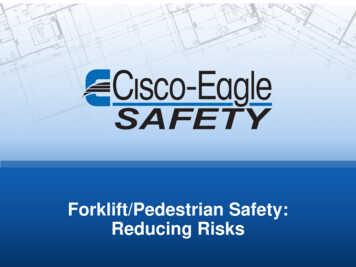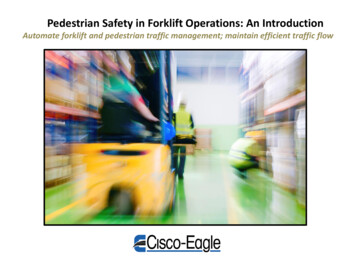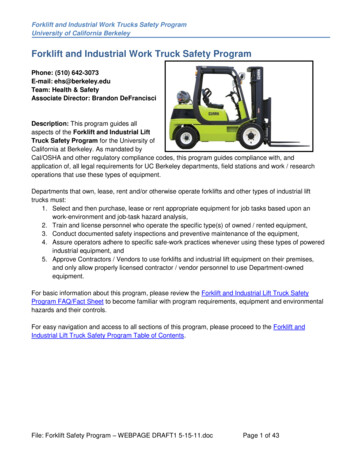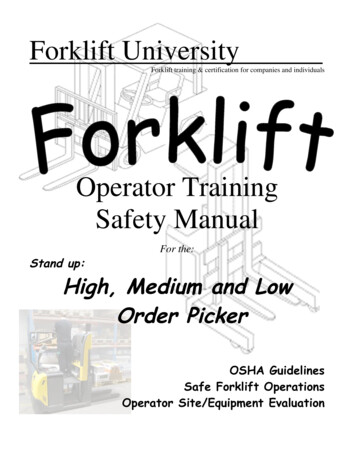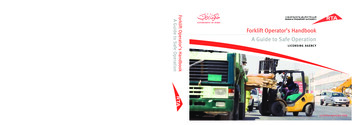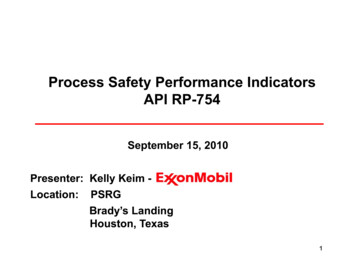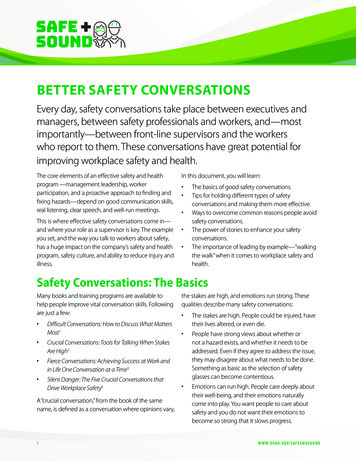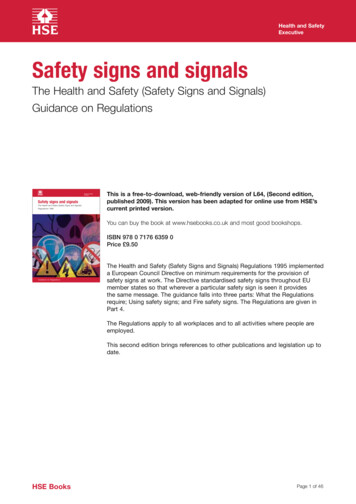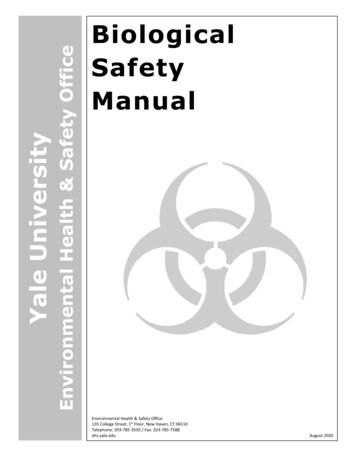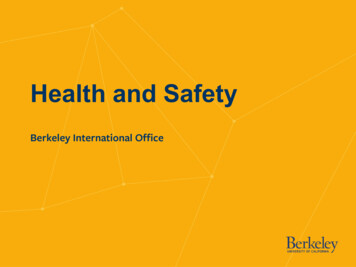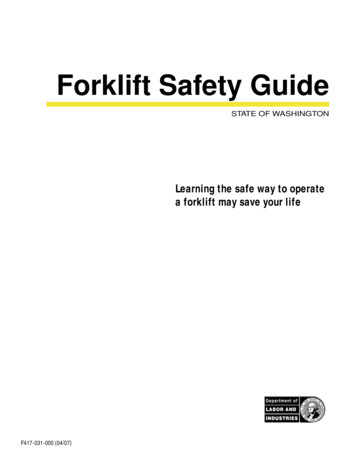
Transcription
Forklift Safety GuideSTATE OF WASHINGTONLearning the safe way to operatea forklift may save your lifeF417-031-000 (04/07)
Forklift Safety GuideSTATE OF WASHINGTONDOSHServicesA Missionto Accomplish:Save Lives.Prevent Injuries and Illnesses.Protect the Safety and Healthof Washington’sWorkers.The Department of Labor and Industries, Division of Occupational Safetyand Health (DOSH), administers the Washington Industrial Safety andHealth Act (WISHA). DOSH is responsible for workplace safety and health.Revised 04/01/2007
Come to the Source!Information on Safety and Health Standards, Ergonomics,WISHA Guidelines, Hazard Alerts, Training Workshops,Proposed Rule Changes, Safety and Health Videos.Labor & Industries’ Safety web site hasthe Answers.Point and Click toThousands of Pagesof Valuable Information.www.LNI.wa.gov/safetyYou can print additional copies of this publication and others, directly from theweb site. Large PDF files should be printed a few pages at a time.
Forklift Safety GuideTable of ContentsAdditional Resources . iiIntroduction. 1How This Book Can Help Prevent Forklift Accidents . 2Types of Forklifts. 3Forklift Operators Must be Trained . 6How a Forklift Works. 8Safely Using a Forklift. 13Driving indoors and Other Hazardous Locations. 21Maintenance of Forklifts . 25Summary . 26AppendicesOperator’s Daily Checklist . AForklift Training Facts (IPUB 417-031-000). 31iRevised 04/01/2007
Additional ResourcesWeb SiteDOSH’s web site is located at www.LNI.wa.gov/safety. The web site providesregulations, policies, news, and additional resources. In addition, the site providesan e-mail feature that allows the user to ask questions and receive a reply.Safety and Health Video LibraryCall 1-800-574-9881 for information on getting safety and health videos.Consultation ServicesL&I’s regional offices offer safety consultation services for employers throughoutthe state. Call the office nearest your workplace for more information.Everett(425) 290-1431Seattle(206) 515-2837Tacoma(253) 596-3917Tumwater(360) 902-5472E. Wenatchee(509) 886-6570Spokane(509) 324-2543Other Resources OSHA Manuals on Forklift Safety OSHA Sample Daily checklists for Powered Industrial Trucks, available daily pit checklist.html Equipment and industry magazines and catalogsRevised 04/01/2007ii
IntroductionA forklift is a powerful tool that allows one person to precisely lift and place largeheavy loads with little effort. Using a tool such as a forklift, cart or hand truckinstead of lifting and carrying items by hand can reduce the risk that you willsuffer a back injury.However, there is great risk of injury or death when a forklift operator: has not been trained in the principles of physics that allows a forklift to liftheavy loads, is not familiar with how a particular forklift operates, operates the forklift carelessly, or uses a forklift that is not safe due to malfunctioning, or missing parts.Every year nearly 100 workers are killed and 20,000 are seriously injured inforklift mishaps. According to the National Traumatic Occupational Fatalities(NTOF) Surveillance System, 1530 workers died from forklift related accidentsbetween 1980 and 2001. The top four types of incidents as a percent of the totalforklift related deaths are:Type of Incident% of total victimsThe forklift overturns22%A worker on foot is struck by the forklift20%A person is crushed by a forklift16%A person falls from a forklift9%A forklift operator was struck andkilled by the overhead guard whenhe attempted to jump as the forkliftoverturned.1Revised 04/01/2007
How this Book Can HelpPrevent Forklift AccidentsThis book has general information about: the kinds of forklifts commonly available the principles of physics that allow a forklift to lift and move heavy loadssafely forklift operator training requirements some basic operator safety rules hazardous locations where carbon monoxide is a problem or a special forkliftis needed safety while servicing a forklift.This book is not designed to substitute for operator training in theoperation of specific forklifts in a specific workplace as required by DOSHregulations.Whenever you see this symbol in the book, it means thatfailure to follow the instructions can result in serious injury ordeath.WISHA standards that regulate forkliftsSafety rules developed under the Washington Industrial Safety and Health Act(WISHA) regulate the safe use of forklifts and other “powered industrial trucks” inWashington workplaces. You can find these rules in:Forklifts and other Powered IndustrialTrucksWAC 296-863Construction StandardWAC 296-155-615(3)Agriculture StandardWAC 296-307-520Longshore, Stevedore and RelatedWaterfront StandardWAC 296-56-60077You can get a copy of these rules on the DOSH web site: www.lni.wa.gov/safetyor by calling the L&I office nearest you.Revised 04/01/20072
Types of ForkliftsA forklift is a type of “powered industrial truck” covered by DOSH standards.Like other powered industrial trucks, its purpose is to move, carry, push, pull,and lift a material load then stack it or place it in a storage rack (tier). Forkliftscome in many sizes and capacities. They can be powered by batteries, propane,gasoline, or diesel fuel. Some are designed to be used in a hazardous location oratmosphere where an ordinary forklift might cause a fire or explosion.Powered industrial trucks are classified into seven types based on theircharacteristics. On the next pages are some illustrations of common forklifts thatfit these classes.ClassTypeClass 1Electric Motor, Rider, Counter-Balanced Trucks (solid andpneumatic tires)Class 2Electric Motor Narrow Aisle Trucks (solid tires)Class 3Electric Motor Hand Trucks or Hand/Rider Trucks (solid tires)Class 4Internal Combustion Engine Trucks (solid tires)Class 5Internal Combustion Engine Trucks (pneumatic tires)Class 6Electric and Internal Combustion Engine Tractors (solid andpneumatic tires). There are no forklifts in this class.Class 7Rough Terrain Forklift Trucks (pneumatic tires)MastForks CounterweightStraddle Leg Stand Up Rider: Forklift has a counterbalanceweight in the body. The rider stands inside thebody of the forklift.Example of:Class 1 Electric Rider Counterbalanced Truck3Stand Up Rider Narrow Aisle: The forklift hasstraddle legs on both sides of the forks to providestability in the absence of a counterweight in thebody.Example of: Class 2 Electric Narrow Aisle TruckRevised 04/01/2007
Types of Forklifts(continued)Operator Controls Operator Platform Stand Up Reach Rider Narrow Aisle: Forksextend in and out as well as up, down, and tilt.Stand Up Rider Order Picker: The operatorstands on a platform in front and along with thecontrols is transported to the elevated location.Example of:Class 2 Electric Narrow Aisle TruckExample of:Class 2 Electric Narrow Aisle TruckSolid Tire Sit Down Rider: The forklift has acounterbalance in the rear.Example of:Class 1 TruckClass 4 TruckClass 5 Truckif electric powered.if internal combustion (gas,diesel or LP gas) poweredwith solid tires.if internal combustionpowered with pneumatic tires.Motorized Hand Pallet Jack: A low lift (groundlevel) unit has forks or a platform. Some modelsallow the operator to stand on the back. Others,like this one, are walked.A high lift version has a mast and straddle legs.Example of:Class 3 Electric Motor Hand/Rider TruckRough Terrain Reach Forklift: The forklift haslarge pneumatic tires. It has a boom which raisesand extends. It has outriggers at the front tostabilize the forklift on soft or uneven ground.Boom A rough terrain forklift might also resemble aOutriggers sit down rider as shown above. It is bigger withlarge pneumatic tires and a large mast with largeforks. It is powered by an internal combustionengine.Example of:Class 7 Rough Terrain Forklift TruckPneumatic (air filled) TireRevised 04/01/20074
Types of Forklifts(continued)Sometimes special attachments are installed onto the forks to extend the reach,clamp a barrel, act as hoist, lift odd-shaped items like a roll of carpet or even liftpeople.Jib Crane AttachmentHoist AttachmentDrum Grabber AttachmentCarpet Lifting AttachmentPersonnel PlatformUsing an unapproved attachment could alter the forklift’s liftingand balance characteristics and lead to a forklift overturning.Whenever an attachment is used that could affect the capacity or safe operationof a forklift, its use must be approved by the forklift manufacturer. The employermust mark the forklift to show the new weight with attachment. The maximumcapacity at the highest elevation must also be shown.5Revised 04/01/2007
Forklift Operators must be trainedAn untrained operator of a forklift can be as dangerous as anunlicensed operator of a motor vehicle.DOSH regulations require that the employer ensure that a forklift operator iscompetent to operate the forklift he or she is assigned to use. The employer mustdocument operator training and an evaluation of the operator’s performance whileusing the forklift.Training has three parts: formal instruction such as a lecture, discussion, interactive computerlearning, videotape and or written material (can be taken anywhere); practical training which includes hands-on demonstrations by the trainerand exercises by the trainee (on the model of forklift the worker will use);and an evaluation of the effectiveness of the training by observing theoperator’s performance while doing actual work using the forklift. Thisevaluation must be repeated at least once every three years (must be atworkplace).Refresher training must be given if the operator has been involved in an accident,near miss or unsafe operations. Also, if an operator is assigned to a new type offorklift or if workplace conditions change that could affect safety, then refreshertraining is required.Forklift operators must be trained in the operating instructions, warnings andprecautions for the types of forklifts they will be authorized to use.Revised 04/01/20076
Forklift Operators must be trained(continued)The topics listed in the table below must be covered when training a forklift operator. If a specific topic does notapply to the forklift in the employer’s workplace, covering it is optional.Topics related to powered industrial trucksTopics related to your workplaceOperating instructionsSurface conditions where the PIT will be operatedWarnings and precautions for the types of PIT theoperator will be authorized to operateComposition of loads to be carried and load stabilityDifferences between the PIT and the automobileLoad manipulation, stacking, and un-stackingPIT controls and instrumentation: Where they arelocated, what they do, and how they workPedestrian traffic in areas where the PIT will be operatedEngine or motor operationNarrow aisles and other restricted places where the PIT willbe operatedSteering and maneuveringUse of door opening and closing devicesVisibility (including restrictions due to loading)Hazardous (classified) locations where the PIT will beoperatedFork and attachment adaptation, operation, and uselimitationsRamps and other sloped surfaces that could affect the PITsstabilityPIT capacityClosed environments and other areas where insufficientventilation or poor PIT maintenance could cause a buildup ofcarbon monoxide or diesel exhaustPIT stabilityOther unique or potentially hazardous environmentalconditions in the workplace that could affect safe operationAny PIT inspection and maintenance that the operatorwill be required to performRefuelingCharging and recharging of batteriesOperating limitationsAny other operating instructions, warnings, orprecautions listed in the operator’s manual for the typesof PIT that the employee is being trained to operateQualified Trainers – The employer or any other person the employer chooses who has the knowledge, trainingand experience to train and evaluate forklift operators can do this training and evaluation. The trainee can onlyoperate the forklift when directly supervised by such a person and when this would not endanger anyone.Documenting Training – If the operator had previous forklift training, the employer must document that thetraining covered the required topics described above. The operator must have been evaluated in the currentworkplace within the last three years.Training and Evaluation Records – The employer must keep a record that shows that each forklift operator hasbeen trained. The record includes the name of the operator, date of training, date of evaluation and the nameof the person(s) giving the training and evaluation.7Revised 04/01/2007
How a Forklift WorksDriving a forklift is different than driving a carIn a car or truck the front wheels steer the vehicle. A forklift has the steeringwheels in the rear. The rear end of the forklift swings in a circle around the frontwheels that support most of the load. The operator must check that there is roomfor the rear end to swing when making turns. This clearance can be maintainedin your workplace by permanently marking aisles with painted lines or arrangingstorage racks in a way that creates obvious aisles for travel. However, thesemar
01.04.2007 · Forklift Safety Guide STATE OF WASHINGTON DOSH Services A Mission to Ac com plish: Save Lives. Prevent Injuries and Ill ness es. Protect the Safety and Health of

